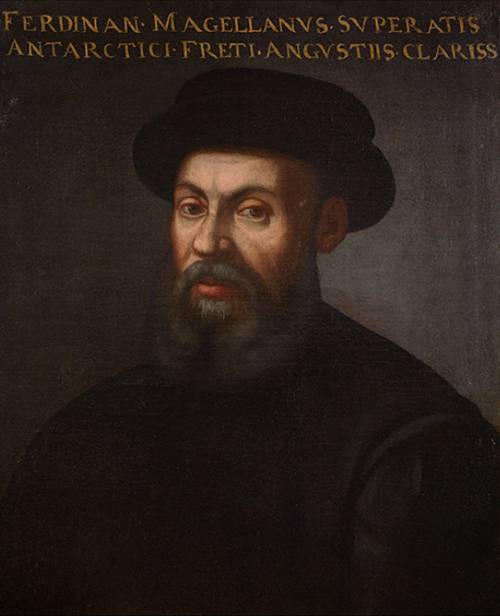
FAQ About Ferdinand Magellan

Who was Ferdinand Magellan?
Ferdinand Magellan was a Portuguese explorer who is best known for leading the first expedition that successfully circumnavigated the globe. Born in 1480, he served under both Portuguese and later Spanish crowns, embarking on an epic voyage on behalf of Spain to find a westward route to the Spice Islands (the Maluku Islands in present-day Indonesia).

What was the main goal of Magellan's expedition?
The main goal of Ferdinand Magellan's expedition was to find a westward maritime route to the Spice Islands, known for their valuable spices like cloves and nutmeg, which were highly sought after in Europe. He aimed to open up a western trade route to these islands under the auspices of the Spanish crown.

What ships were part of Magellan's fleet?
Magellan's fleet, known as the Armada de Molucca, originally comprised five ships: the Trinidad, San Antonio, Concepción, Victoria, and Santiago. These ships supported the ambitious goal of reaching the Spice Islands by sailing westward from Europe.

How many ships returned from Magellan's voyage?
Out of the five ships that initially set out on Magellan's voyage, only one ship—Victoria—successfully returned to Spain. The Victoria completed the first circumnavigation of the globe on September 6, 1522.

What challenges did Magellan's expedition face?
Magellan's expedition faced numerous challenges, including treacherous weather conditions, conflicts with indigenous peoples, the mutiny of crew members, navigation in uncharted territories, and desperate shortages of food and fresh water. These obstacles led to significant losses, including the death of Magellan and many crew members.

How did Magellan die?
Ferdinand Magellan died on April 27, 1521, during the Battle of Mactan in the Philippines. He was killed while attempting to suppress a resistance led by a local chieftain named Lapu-Lapu. Magellan's attempts to convert the indigenous people to Christianity and his involvement in local politics led to his untimely death.

What impact did Magellan's voyage have on the world?
Magellan's voyage had a profound impact on the world by proving that the Earth could be circumnavigated by sea, challenging existing geographical theories. It improved navigation techniques and maritime technology, opened new sea routes, and established Spain as a dominant global power in trade with the East. The expedition also laid the groundwork for future explorations and interactions between Europe and the newfound territories.

Was Magellan's expedition considered a success despite his death?
While Ferdinand Magellan himself did not survive the expedition, it is considered a remarkable success. Despite heavy losses, including Magellan's own life, the completion of the first circumnavigation by the remaining crew under Elcano demonstrated the feasibility of global sea travel and greatly expanded geographical knowledge.

What was the Treaty of Tordesillas and how did it relate to Magellan's voyage?
The Treaty of Tordesillas was an agreement between Spain and Portugal, signed in 1494, which divided the newly discovered lands outside Europe between the two empires along a meridian 370 leagues west of the Cape Verde islands. Although it predated Magellan's voyage, this treaty influenced his journey as it delineated areas of exploration and influence for the Spanish and Portuguese crowns, allowing Magellan, sailing for Spain, to seek a western route to the Spice Islands.

Which technological advancements during Magellan's time facilitated his expedition?
Several technological advancements facilitated Magellan's expedition, including advancements in navigation such as the astrolabe and compass, which allowed for better determination of latitude and direction at sea. Maritime technology improvements, such as sturdier ship designs capable of withstanding the harshest ocean conditions, also played a crucial role. Additionally, cartographic advances provided more detailed maps to aid navigation.

How many crew members survived Magellan's expedition?
Out of the approximately 270 crew members who initially set out on Magellan's expedition, only 18 managed to survive and return to Spain. The majority of the crew lost their lives due to a variety of factors such as conflict, disease, and harsh conditions during the three-year voyage.

Who was Juan Sebastián Elcano and what was his role in the expedition?
Juan Sebastián Elcano was a Spanish explorer and mariner who played a vital role in Magellan's expedition. After Magellan's death in the Philippines, Elcano took command of the expedition and led the remaining crew back to Spain, successfully completing the first circumnavigation of the globe.

What were the Spice Islands, and why were they important?
The Spice Islands, now part of modern Indonesia's Maluku Islands, were famous for their production of cloves, nutmeg, and mace, which were highly prized in Europe. These spices were so valuable that they were sometimes worth their weight in gold, prompting European powers to seek direct trade routes to these islands, thereby bypassing middlemen and reducing costs.

How did Magellan's voyage change the map of the world?
Magellan's voyage significantly altered the European understanding of world geography. By proving it was possible to sail from the Atlantic to the Pacific Ocean via the strait that now bears his name, and by demonstrating the vastness of these oceans, the expedition changed maritime maps extensively. It also added vast swaths of previously unknown territories to the global map, facilitating further explorations.

What was the Strait of Magellan, and why is it significant?
The Strait of Magellan is a navigable sea route in southern Chile that separates the mainland from Tierra del Fuego. Named after Ferdinand Magellan, it holds significant historical importance as it was the first discovered marine pathway from the Atlantic Ocean to the Pacific Ocean, avoiding the dangerous Drake Passage and Cape Horn at the continent's southern tip.

Did Magellan have any conflicts with his crew during the expedition?
Yes, Magellan experienced several conflicts with his crew during the expedition. A notable incident was a mutiny that occurred during the winter of 1520 while the fleet was anchored in the port of San Julián (Patagonia), where dissatisfaction with his leadership led to unrest. Magellan acted swiftly to suppress the mutiny, executing some of the leading mutineers and reinforcing his authority among the remaining men.
